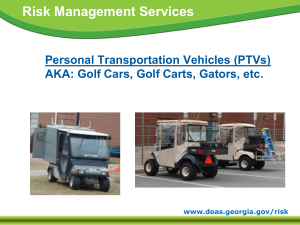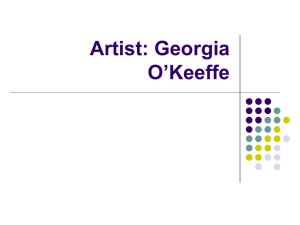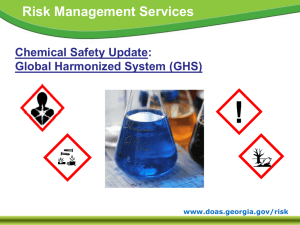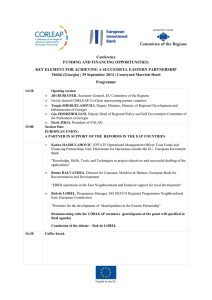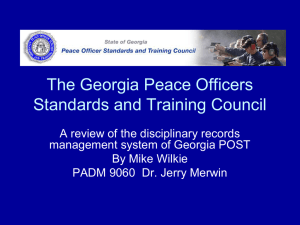Georgia Department of Administrative Services
advertisement
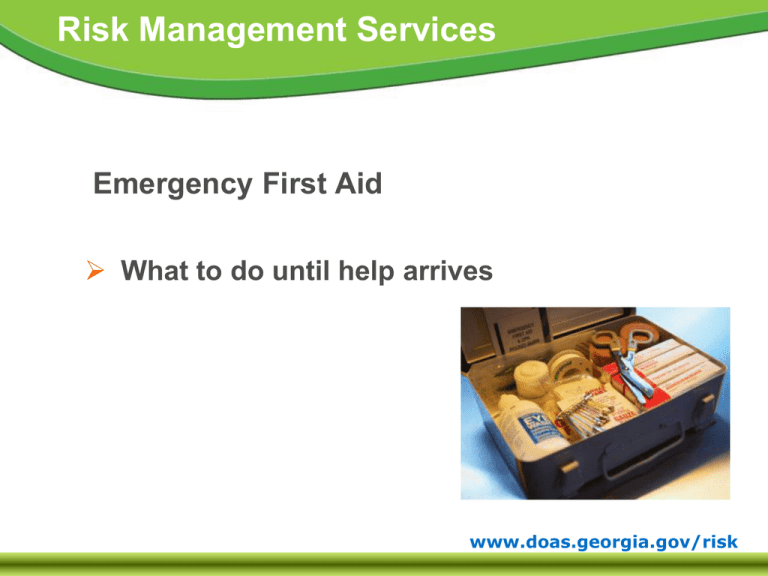
Risk Management Services Emergency First Aid What to do until help arrives www.doas.georgia.gov/risk Risk Management Services OBJECTIVES Rescuer Duties Rescuer & Victim Safety Phoning for Help Finding the Problem Treatment *This PowerPoint is informational level only and reviews the first aid basics. It does not qualify you to provide first aid treatment. Please complete a certified First Aid course prior to treatment. www.doas.georgia.gov/risk Risk Management Services RESCUER RESPONSIBILITIES If you are a CERTIFIED First Aid provider for your workplace you must provide help. Providing help outside of work is your choice. Tell the victim your name. Ask if they want help: If they appear to be in distress but do not want your help, you should still call 911. If they cannot answer or are confused, you should assume they want your help. www.doas.georgia.gov/risk Risk Management Services RESCUER & VICTIM SAFETY Don’t become a victim unless necessary. If the victim has suffered a traumatic injury, DO NOT move the victim. If the victim is down in the road or street, use a vehicle to block the road. Stay out of Electrical & Mechanical Hazards; there probably is no way for you to move safely. Blood/fluids from the victim could be hazardous to YOU. Use universal precautions. Forget most of what you have seen on TV/Movies. www.doas.georgia.gov/risk Risk Management Services PHONING FOR HELP 911 or site emergency number Send someone else to call Information to give to dispatch: Your name Street Address Building number Room number Phone number Emergency situation information www.doas.georgia.gov/risk Risk Management Services FINDING THE PROBLEM Check for scene safety. Gently tap the victim and ask, “Are you ok?” If the victim does not answer, check to see if they are breathing. Look for medical alert jewelry. HIPPA laws apply. Do not share any information about victims. www.doas.georgia.gov/risk Risk Management Services MEDICAL EMERGENCIES Breathing Problems: Signs and Symptoms Very fast or slow Have difficulty with every breath Noisy breathing Trouble speaking People with chronic breathing problems may have medication with them. www.doas.georgia.gov/risk Risk Management Services MEDICAL EMERGENCIES Choking Signs & Symptoms Can’t breath Quiet cough Can’t talk or make sounds Noisy breathing Blue lips Makes choking sign Loss of consciousness Heimlich Maneuver www.doas.georgia.gov/risk Risk Management Services MEDICAL EMERGENCIES Chest Pain Signs and Symptoms Heavy pressure or squeezing feeling Pain radiates to the jaw, left shoulder or arm, and/or back Shortness of breath Sweating Nausea Lightheadedness Have the victim sit and try to keep calm. Concentrate on breathing and phone for help immediately. www.doas.georgia.gov/risk Risk Management Services MEDICAL EMERGENCIES Diabetes Signs and Symptoms Behavior change Irritable Confused Hungry/Thirsty Weak Sweaty Give the victim sugar (no diet drinks or sugar substitute). Have the victim sit or lie down. www.doas.georgia.gov/risk Risk Management Services MEDICAL EMERGENCIES Stroke Signs and Symptoms Sudden numbness or weakness (normally on one side) Confusion Trouble speaking or understanding Sudden trouble seeing Trouble walking, dizziness Severe headache Have victim sit or lie down. www.doas.georgia.gov/risk Risk Management Services MEDICAL EMERGENCIES Allergic Reaction Signs and Symptoms Trouble breathing Trouble talking Swelling of the throat and/or tongue Hives/Rash Call 911 immediately. Have the victim sit down and monitor their breathing. www.doas.georgia.gov/risk Risk Management Services MEDICAL EMERGENCIES Allergic reactions, many people with known Sensitivity carry Epinephrine pens for emergency treatment. Epinephrine Pen Inject into side of thigh www.doas.georgia.gov/risk Risk Management Services MEDICAL EMERGENCIES Seizure Signs and Symptoms Jerking movement of the arms, legs or other parts of the body. Last a few seconds to a few minutes. Move things out of the way. Roll victim on their side after seizure. DO NOT hold the victim down or put anything in their mouth. www.doas.georgia.gov/risk Risk Management Services TRAUMA EMERGENCIES Bleeding Bleeding you can see (external) Control bleeding with direct pressure. Use sterile gauze from a first aid kit (if available). DO NOT remove gauze. DO NOT remove objects that have punctured the skin. Bleeding you can’t see (internal) Caused from traumatic injury to the abdomen or chest. www.doas.georgia.gov/risk Risk Management Services HEAD & SPINE INJURIES Head injuries Signs and Symptoms Does not respond Sleepy or confused Vomits Complains of headaches Trouble seeing or walking Seizures possible www.doas.georgia.gov/risk Risk Management Services HEAD & SPINE INJURIES (cont’d) Spine Injuries Signs and Symptoms Injury to upper body (head/chest) Blow to the head Crash or fall www.doas.georgia.gov/risk Risk Management Services HEAD & SPINE INJURIES Head and Spine Injury Treatment Make sure the scene is safe. Phone for help. Hold the head and neck. DO NOT move the victim unless danger to life exists. www.doas.georgia.gov/risk Risk Management Services BROKEN BONES/SPRAINS/BRUISES Treatment: Scene safe Check the victim for shock. DO NOT straighten bent parts. Cover open wounds. Place a bag of ice on injured area. Raise injured body part IF doing so does not cause more pain. Phone for help. www.doas.georgia.gov/risk Risk Management Services SHOCK Shock develops when there is not enough blood flowing to important parts of the body. Signs and Symptoms of Shock Weakness Faint or dizzy Pale or gray skin Restless, agitated or confused Cold and Clammy www.doas.georgia.gov/risk Risk Management Services SHOCK Treatment for Shock Scene safe Phone for help. Place the victim on their back if possible. Raise the victim’s legs about 12 inches. Use direct pressure to control bleeding. Cover the victim with a blanket. www.doas.georgia.gov/risk Risk Management Services Questions? Again, this is simply an informational program. We encourage you to find and complete a fully certified first aid program. Contact Information C. G. Lawrence, III, MS, CSP, REM, ARM-P Chief Loss Control & Safety Officer (404) 657-4457 Charles.Lawrence@doas.ga.gov www.doas.georgia.gov/risk

